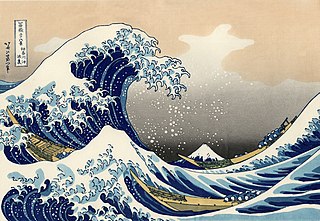
The Ogasawara clan was a Japanese samurai clan descended from the Seiwa Genji. The Ogasawara acted as shugo (governors) of Shinano Province in the medieval period, and as daimyō of territories on Kyūshū during the Edo period (1600–1867).
The Hikone Domain was a feudal domain of Japan during the Edo period. It was established in 1600 with Ii Naomasa as the first daimyō. All fifteen daimyō were from the Ii clan.
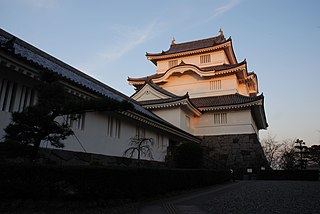
Ōtaki Domain was a feudal domain under the Tokugawa shogunate of the Edo period, located in Kazusa Province, Japan. It was centered on Ōtaki Castle in what is now the town of Ōtaki, Chiba.

Odawara Domain was a Japanese domain of the Edo period, located primarily in western Sagami Province. It was centered on Odawara Castle in what is now the city of Odawara.

The Niwase Domain was a Japanese domain of the Edo period. It was associated with Bitchū Province in modern-day Okayama Prefecture.

The Bitchū-Matsuyama Domain was a Japanese domain of the Edo period, located in Bitchū Province.

The Himeji Domain was a Japanese domain of the Edo period, located in Harima Province.

The Yodo Domain was a Japanese domain of the Edo period, and the only domain located in Yamashiro Province. Its castle was located within modern-day Fushimi, Kyoto.

The Akashi Domain was a feudal domain of Japan. It occupied Akashi District and surroundings in Harima Province. Fudai and Shimpan daimyō were assigned, and frequently reassigned, to Akashi. The domain had its administrative headquarters at Akashi Castle.

Kokura Domain', also known as "Kawara-han" (香春藩) or then "Toyotsu-han" (豊津藩), was a Japanese domain of the Edo period. It was associated with Buzen Province in modern-day Fukuoka Prefecture on the island of Kyushu.
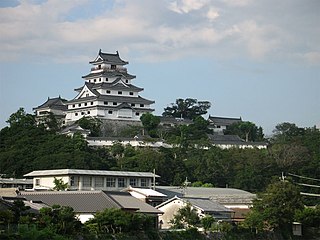
Karatsu Domain was a Japanese domain of the Edo period. It is associated with Hizen Province in modern-day Saga Prefecture.

The Hamada Domain was a Japanese domain of the Edo period. It was associated with Iwami Province in modern-day Shimane Prefecture.
The Miyazu Domain was a Japanese domain of the Edo period, located in Tango Province.
Kanō Domain was a fudai feudal domain of Edo period Japan. The domain was centered at Kanō Castle, located in what is now part of the city of Gifu in Gifu Prefecture.
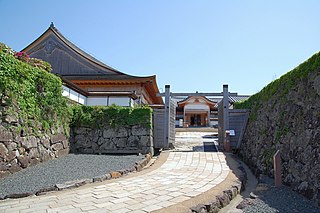
Sasayama Domain was a Japanese domain of the Edo period, located in Tanba Province. It was founded in 1609, when Matsudaira Yasushige moved there from the Yakami Domain. The domain changed hands several times until 1748, when it was given to Aoyama Tadatomo. The Aoyama family remained there until 1868; the domain itself was abolished in 1871. Its territory first became part of the short-lived Toyooka Prefecture, before being made part of Hyogo Prefecture in 1876; it remains part of Hyogo Prefecture to the present day.
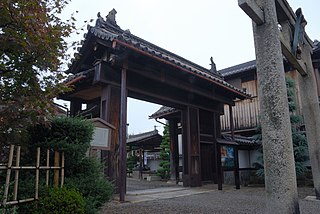
The Zeze Domain was a feudal domain in Japan during the Edo period. It was established by Tokugawa Ieyasu as a reward to Toda Kazuaki, whom he transferred from a 5,000 koku territory in Musashi Province to this 30,000 koku domain in Ōmi Province. The domain government had its headquarters at Zeze Castle in what is now the city of Ōtsu, Shiga Prefecture. At its peak, it had a rating of 70,000 koku. It continued throughout the Edo period until the 1871 abolition of the han system.

The Ōgaki Domain was a Japanese domain during the Edo period, located in Mino Province.

The Ōkubo clan were a samurai kin group which rose to prominence in the Sengoku period and the Edo periods. Under the Tokugawa shogunate, the Ōkubo, as hereditary vassals of the Tokugawa clan, were classified as one of the fudai daimyō clans.
Ōkubo Tadatomo was a daimyō in early Edo period, Japan. He was assigned by the Tokugawa shogunate to Karatsu Domain, Sakura Domain, and finally to Odawara Domain in Sagami Province,, where his descendants remained until the Meiji Restoration.
Awa-Katsuyama Domain was a feudal domain under the Tokugawa shogunate of Edo period Japan, located in Awa Province, Japan. It was centered in what is now part of the city of Kamogawa, Chiba.
